2004 YAMAHA AEROX50 maintenance
[x] Cancel search: maintenancePage 54 of 84

PERIODIC MAINTENANCE AND MINOR REPAIR
6 Tire inspection
The tires must be checked before each
ride. If the center tread depth reaches
the specified limit, if the tire has a nail
or glass fragments in it, or if the sidewall
is cracked, have a Yamaha dealer re-
place the tire immediately.
1
2
ZAUM0054
1. Tread depth
2. Side wall
Tire information
This scooter is equipped with tubeless
tires.
Minimum tire tread depth
(front and rear)1.6 mm
NOTE :
The tire tread depth limits may differ
from country to country. Always comply
with the local regulations.
Front
Manufacturer Size Type
PIRELLIM 130/60-13M SL36
Rear
Manufacturer Size Type
MICHELINM 130/60-13M BOPPER
PIRELLIM 130/60-13M EVO 21
PIRELLIM 140/60-13M SL36
MICHELINM 140/60-13M BOPPER
PIRELLIM 140/60-13 M EVO 22
6-12
EW000077
Because loading has an enormous
impact on the handling, braking, per-
formance and safety characteristics of
your scooter, you should keep the
following precautions in mind.
•NEVER OVERLOAD THE SCOO-
TER! Operation of an overloaded
scooter may result in tire damage,
loss of control, or severe injury.
Make sure that the total weight of
rider, cargo, and accessories
does not exceed the specified
maximum load for the vehicle.
•Do not carry along loosely
packed items, which can shift
during a ride.
•Securely pack the heaviest items
close to the center of the scooter
and distribute the weight evenly
on both sides.
•Adjust the suspension and tire air
pressure with regard to the load.
•Check the tire condition and air
pressure before each ride.
WARNING
Page 55 of 84
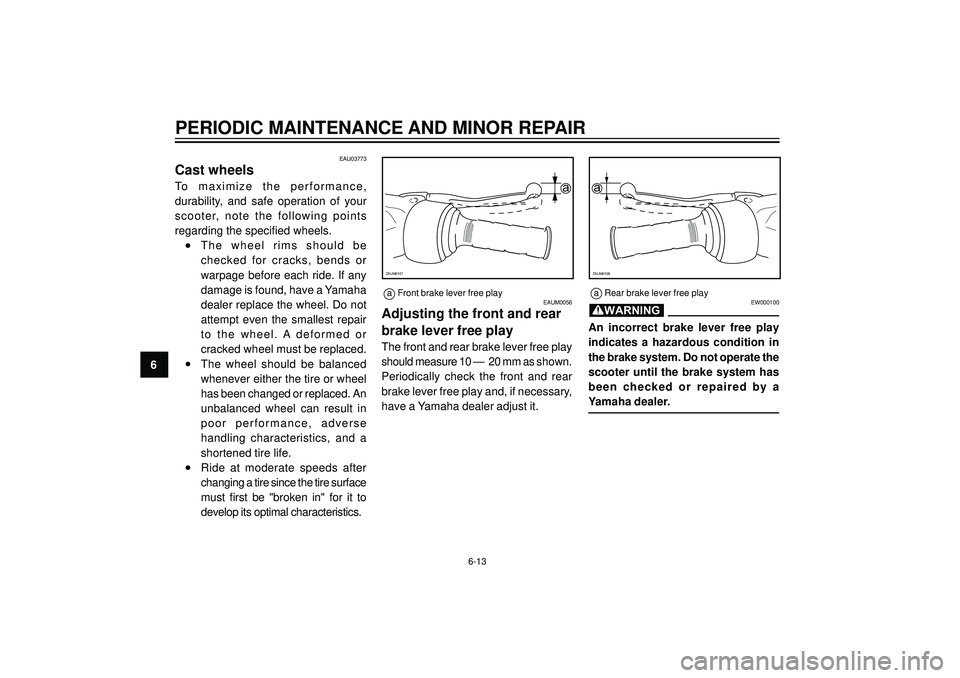
PERIODIC MAINTENANCE AND MINOR REPAIR
6
EAUM0056
Adjusting the front and rear
brake lever free play
The front and rear brake lever free play
should measure 10 — 20 mm as shown.
Periodically check the front and rear
brake lever free play and, if necessary,
have a Yamaha dealer adjust it.
EW000100
An incorrect brake lever free play
indicates a hazardous condition in
the brake system. Do not operate the
scooter until the brake system has
been checked or repaired by a
Yamaha dealer.
WARNING
a
ZAUM0107
a
ZAUM0108
a Front brake lever free playa Rear brake lever free play
6-13
EAU03773
Cast wheels
To maximize the performance,
durability, and safe operation of your
scooter, note the following points
regarding the specified wheels.
•The wheel rims should be
checked for cracks, bends or
warpage before each ride. If any
damage is found, have a Yamaha
dealer replace the wheel. Do not
attempt even the smallest repair
to the wheel. A deformed or
cracked wheel must be replaced.
•The wheel should be balanced
whenever either the tire or wheel
has been changed or replaced. An
unbalanced wheel can result in
poor performance, adverse
handling characteristics, and a
shortened tire life.
•Ride at moderate speeds after
changing a tire since the tire surface
must first be "broken in" for it to
develop its optimal characteristics.
Page 56 of 84
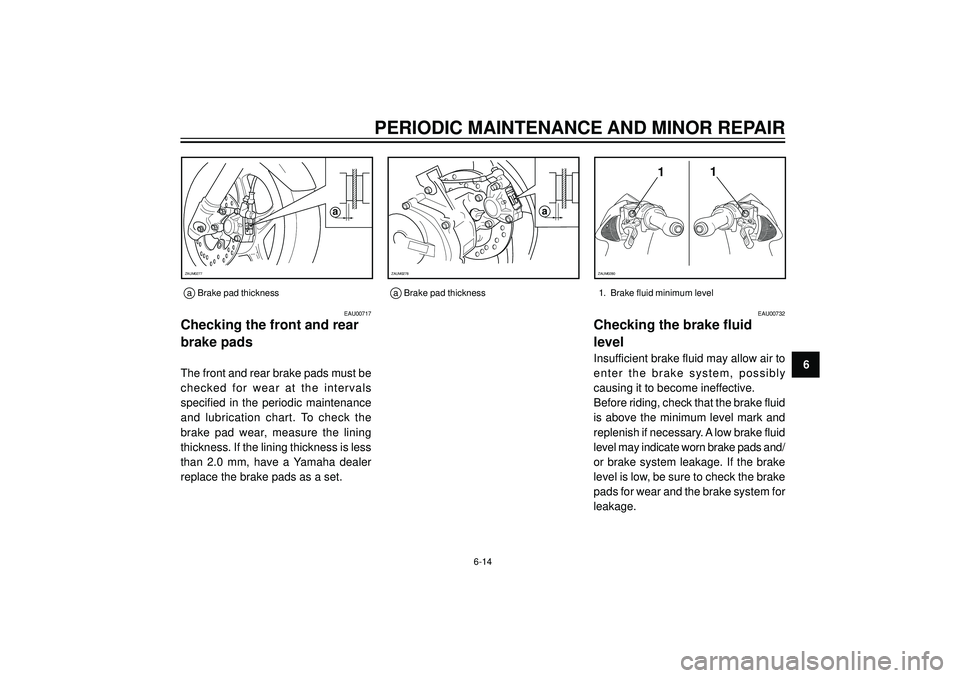
PERIODIC MAINTENANCE AND MINOR REPAIR
6
EAU00717
Checking the front and rear
brake pads
The front and rear brake pads must be
checked for wear at the intervals
specified in the periodic maintenance
and lubrication chart. To check the
brake pad wear, measure the lining
thickness. If the lining thickness is less
than 2.0 mm, have a Yamaha dealer
replace the brake pads as a set.
a
ZAUM0277
a
ZAUM0278
a Brake pad thicknessa Brake pad thickness
EAU00732
Checking the brake fluid
level
Insufficient brake fluid may allow air to
enter the brake system, possibly
causing it to become ineffective.
Before riding, check that the brake fluid
is above the minimum level mark and
replenish if necessary. A low brake fluid
level may indicate worn brake pads and/
or brake system leakage. If the brake
level is low, be sure to check the brake
pads for wear and the brake system for
leakage.
11
ZAUM0280
1. Brake fluid minimum level
6-14
Page 57 of 84
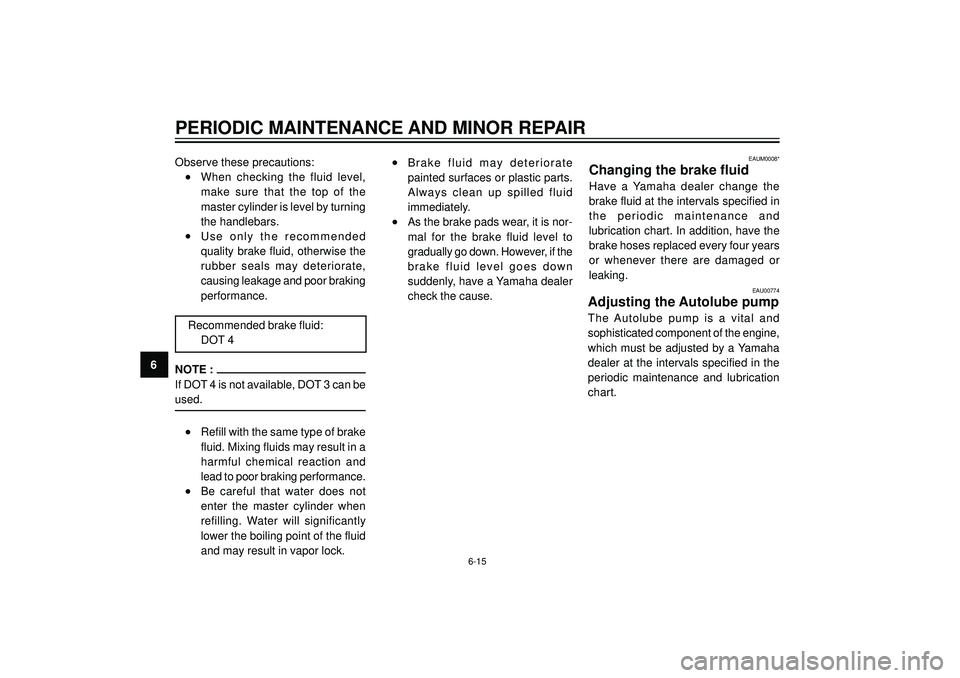
PERIODIC MAINTENANCE AND MINOR REPAIR
6Observe these precautions:
•When checking the fluid level,
make sure that the top of the
master cylinder is level by turning
the handlebars.
•Use only the recommended
quality brake fluid, otherwise the
rubber seals may deteriorate,
causing leakage and poor braking
performance.
Recommended brake fluid:
DOT 4
NOTE :
If DOT 4 is not available, DOT 3 can be
used.
•Refill with the same type of brake
fluid. Mixing fluids may result in a
harmful chemical reaction and
lead to poor braking performance.
•Be careful that water does not
enter the master cylinder when
refilling. Water will significantly
lower the boiling point of the fluid
and may result in vapor lock.
•Brake fluid may deteriorate
painted surfaces or plastic parts.
Always clean up spilled fluid
immediately.
•As the brake pads wear, it is nor-
mal for the brake fluid level to
gradually go down. However, if the
brake fluid level goes down
suddenly, have a Yamaha dealer
check the cause.
EAUM0008*
Changing the brake fluid
Have a Yamaha dealer change the
brake fluid at the intervals specified in
the periodic maintenance and
lubrication chart. In addition, have the
brake hoses replaced every four years
or whenever there are damaged or
leaking.
6-15
EAU00774
Adjusting the Autolube pump
The Autolube pump is a vital and
sophisticated component of the engine,
which must be adjusted by a Yamaha
dealer at the intervals specified in the
periodic maintenance and lubrication
chart.
Page 58 of 84
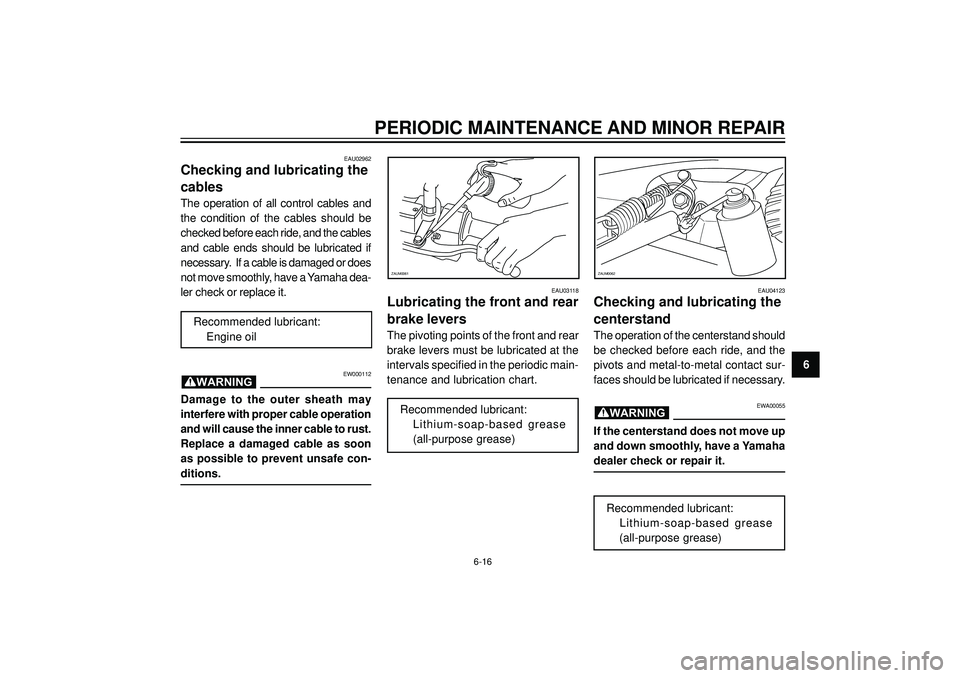
PERIODIC MAINTENANCE AND MINOR REPAIR
6
ZAUM0061
EAU03118
Lubricating the front and rear
brake levers
The pivoting points of the front and rear
brake levers must be lubricated at the
intervals specified in the periodic main-
tenance and lubrication chart.
Recommended lubricant:
Lithium-soap-based grease
(all-purpose grease)
ZAUM0062
EAU04123
Checking and lubricating the
centerstand
The operation of the centerstand should
be checked before each ride, and the
pivots and metal-to-metal contact sur-
faces should be lubricated if necessary.
EWA00055
If the centerstand does not move up
and down smoothly, have a Yamaha
dealer check or repair it.
Recommended lubricant:
Lithium-soap-based grease
(all-purpose grease)
WARNING
6-16
EAU02962
Checking and lubricating the
cables
The operation of all control cables and
the condition of the cables should be
checked before each ride, and the cables
and cable ends should be lubricated if
necessary. If a cable is damaged or does
not move smoothly, have a Yamaha dea-
ler check or replace it.
Recommended lubricant:
Engine oil
EW000112
Damage to the outer sheath may
interfere with proper cable operation
and will cause the inner cable to rust.
Replace a damaged cable as soon
as possible to prevent unsafe con-
ditions.
WARNING
Page 59 of 84
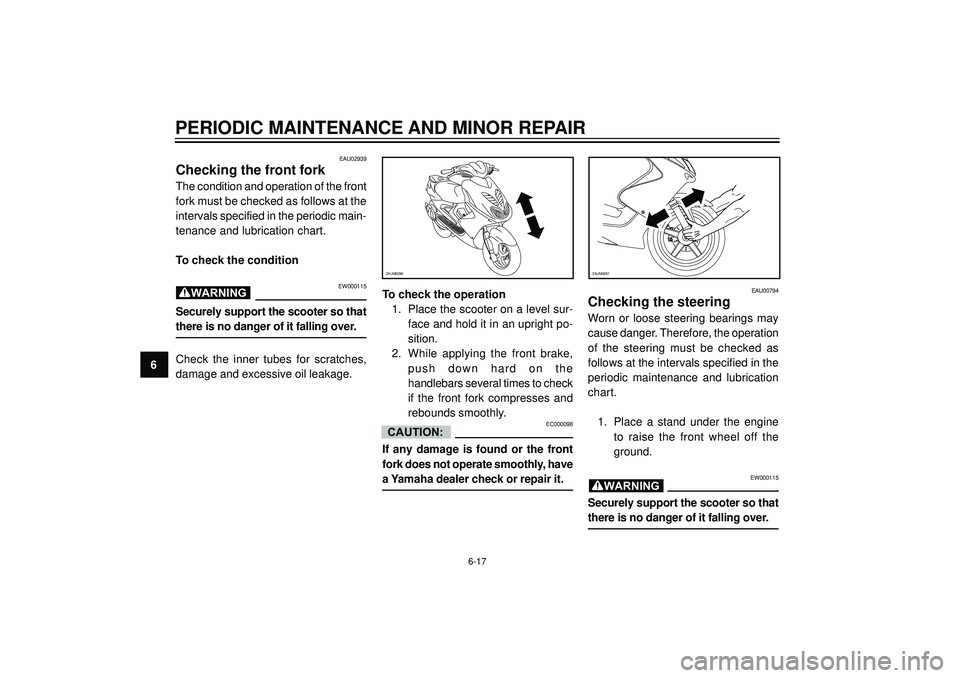
PERIODIC MAINTENANCE AND MINOR REPAIR
6
EAU02939
Checking the front fork
The condition and operation of the front
fork must be checked as follows at the
intervals specified in the periodic main-
tenance and lubrication chart.
To check the condition
EW000115
Securely support the scooter so that
there is no danger of it falling over.
Check the inner tubes for scratches,
damage and excessive oil leakage.
WARNINGTo check the operation
1. Place the scooter on a level sur-
face and hold it in an upright po-
sition.
2. While applying the front brake,
push down hard on the
handlebars several times to check
if the front fork compresses and
rebounds smoothly.
EC000098
If any damage is found or the front
fork does not operate smoothly, have
a Yamaha dealer check or repair it.
CAUTION:
EAU00794
Checking the steering
Worn or loose steering bearings may
cause danger. Therefore, the operation
of the steering must be checked as
follows at the intervals specified in the
periodic maintenance and lubrication
chart.
1. Place a stand under the engine
to raise the front wheel off the
ground.
EW000115
Securely support the scooter so that
there is no danger of it falling over.
WARNING
6-17
ZAUM0296ZAUM0297
Page 60 of 84
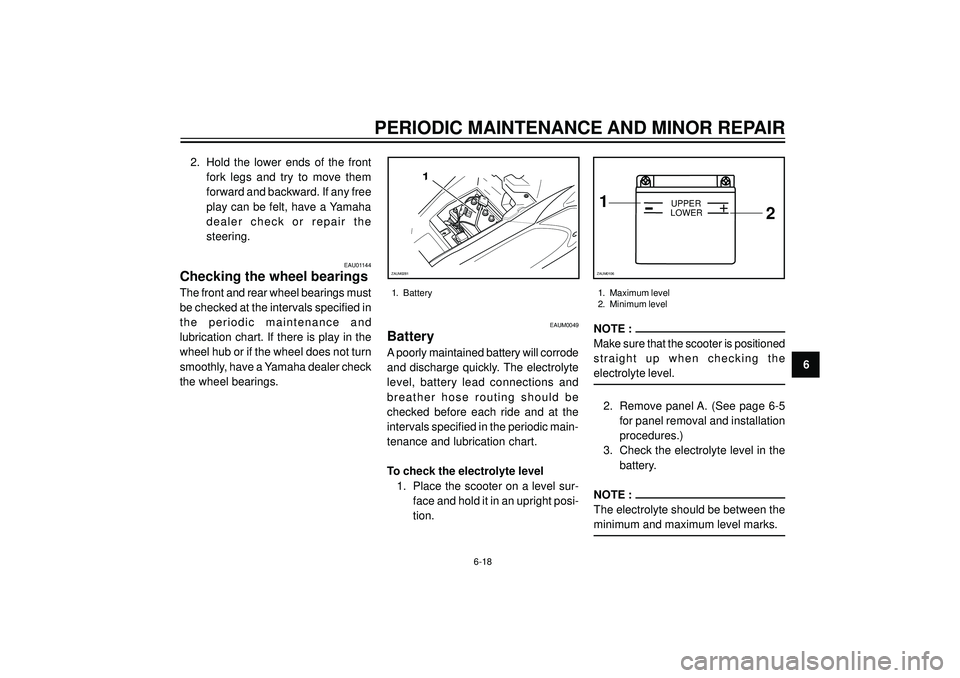
PERIODIC MAINTENANCE AND MINOR REPAIR
6
EAU01144
Checking the wheel bearings
The front and rear wheel bearings must
be checked at the intervals specified in
the periodic maintenance and
lubrication chart. If there is play in the
wheel hub or if the wheel does not turn
smoothly, have a Yamaha dealer check
the wheel bearings.
1
ZAUM0281
1. Battery
EAUM0049
Battery
A poorly maintained battery will corrode
and discharge quickly. The electrolyte
level, battery lead connections and
breather hose routing should be
checked before each ride and at the
intervals specified in the periodic main-
tenance and lubrication chart.
To check the electrolyte level
1. Place the scooter on a level sur-
face and hold it in an upright posi-
tion.
NOTE :
Make sure that the scooter is positioned
straight up when checking the
electrolyte level.
2. Remove panel A. (See page 6-5
for panel removal and installation
procedures.)
3. Check the electrolyte level in the
battery.
NOTE :
The electrolyte should be between the
minimum and maximum level marks.
1
2+UPPER
LOWER
ZAUM0106
1. Maximum level
2. Minimum level
6-18
2. Hold the lower ends of the front
fork legs and try to move them
forward and backward. If any free
play can be felt, have a Yamaha
dealer check or repair the
steering.
Page 61 of 84
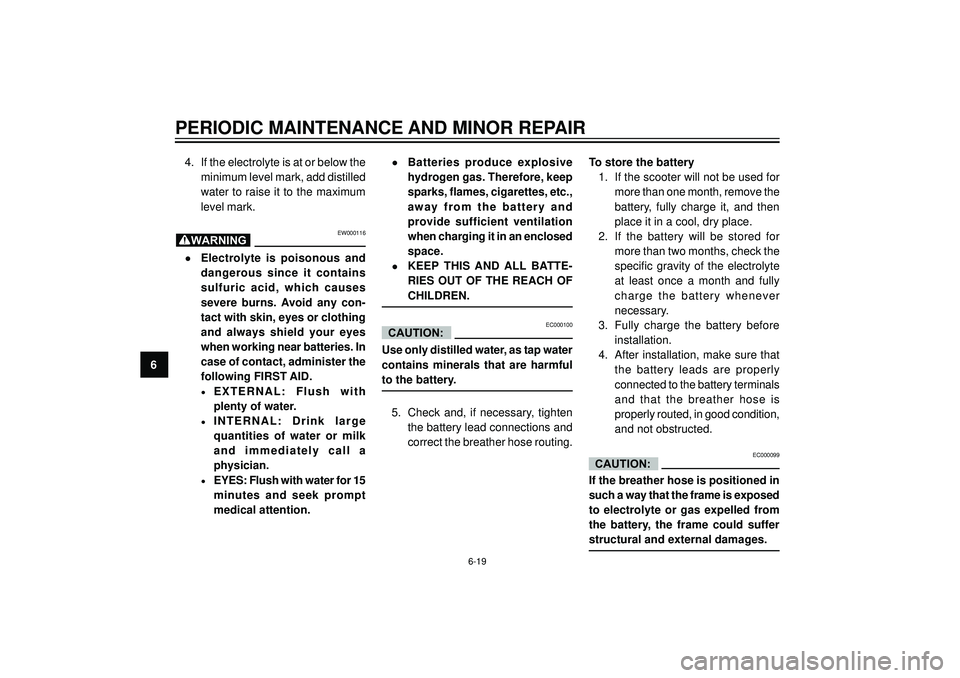
PERIODIC MAINTENANCE AND MINOR REPAIR
64. If the electrolyte is at or below the
minimum level mark, add distilled
water to raise it to the maximum
level mark.
EW000116
•Electrolyte is poisonous and
dangerous since it contains
sulfuric acid, which causes
severe burns. Avoid any con-
tact with skin, eyes or clothing
and always shield your eyes
when working near batteries. In
case of contact, administer the
following FIRST AID.
•EXTERNAL: Flush with
plenty of water.
•INTERNAL: Drink large
quantities of water or milk
and immediately call a
physician.
•EYES: Flush with water for 15
minutes and seek prompt
medical attention.
•Batteries produce explosive
hydrogen gas. Therefore, keep
sparks, flames, cigarettes, etc.,
away from the battery and
provide sufficient ventilation
when charging it in an enclosed
space.
•KEEP THIS AND ALL BATTE-
RIES OUT OF THE REACH OF
CHILDREN.
EC000100
Use only distilled water, as tap water
contains minerals that are harmful
to the battery.
5. Check and, if necessary, tighten
the battery lead connections and
correct the breather hose routing.
WARNING
CAUTION:
To store the battery
1. If the scooter will not be used for
more than one month, remove the
battery, fully charge it, and then
place it in a cool, dry place.
2. If the battery will be stored for
more than two months, check the
specific gravity of the electrolyte
at least once a month and fully
charge the battery whenever
necessary.
3. Fully charge the battery before
installation.
4. After installation, make sure that
the battery leads are properly
connected to the battery terminals
and that the breather hose is
properly routed, in good condition,
and not obstructed.
EC000099
If the breather hose is positioned in
such a way that the frame is exposed
to electrolyte or gas expelled from
the battery, the frame could suffer
structural and external damages.
CAUTION:
6-19